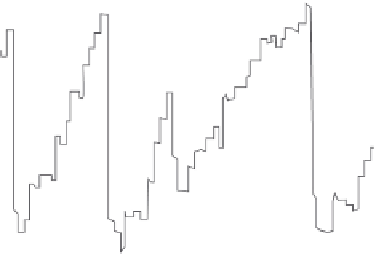Biomedical Engineering Reference
In-Depth Information
comprehension of the patient's skills. However, it is important to emphasize in particular
the part of automaticity, which is seldom taken into account in the tests. We often obtain
good performance from the patients, a continuous, stable pursuit that is often carried out
together with rotations, but when the patient is asked to perform even a slight gesture,
such as clapping hands, or a simple verbal request, such as counting to ten, it is possible to
observe an evident loss in performance quality. This indicates that the subject needs to use
his full attention to control the visual performance and that the slight interference breaks
this control. This reproduces the effect of a realistic behavior during a visual pursuit as
might occur in real life or during the use of an assistive device.
10.2.2.4 Saccadic Movements
Saccadic movements represent the most frequent eye movement. These movements are
used during the visual exploration of the environment, when we read, and when we look
distractedly without really looking at something. Saccades are characterized by a very
rapid movement that shifts the eye to a target identified through peripheral vision. During
this movement, a phenomenon known as saccadic masking occurs by “blocking” the
visual process to avoid the unfocused and blurred images that are observed. At the end of
this movement, a phase of stillness occurs, namely fixation, during which the information
is acquired (Traccis and Zambardieri 1992). The quantity of information acquired mainly
depends in this case on central factors. Saccades cannot provide for a continuous feedback:
Verifying the correctness of the movement can be done only after the movement is com-
pleted, and in case of error, the only possible thing to do is to perform a new corrective
movement (Figure 10.14).
Programming and performing saccades is a very complex task because the movement
must be calculated in advance, during the central foveal fixation, using peripheral infor-
mation filtered on the basis of minimal shape and movement indicators. Any deficiency
in each of the above-mentioned passages can lead to inaccurate or insufficient saccade.
We can observe dysmetric saccadic movements, as well as hypometric and hypermetric
saccades, slightly elicited, with reduced shifting speed or an insufficient level of visual
information acquisition.
SR reaserch ELII
1000
900
800
700
600
500
400
300
200
100
0
Left eye
FIgUre 10.14
Eye movements during reading text (Centro Ricerche sulla Visione Roma, www.crvisione.it).























